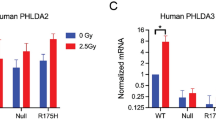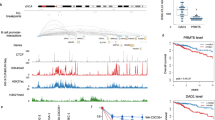Abstract
The ATM protein kinase, functionally missing in patients with the human genetic disorder ataxia-telangiectasia, is a master regulator of the cellular network induced by DNA double-strand breaks. The ATM gene is also frequently mutated in sporadic cancers of lymphoid origin. Here, we applied a functional genomics approach that combined gene expression profiling and computational promoter analysis to obtain global dissection of the transcriptional response to ionizing radiation in murine lymphoid tissue. Cluster analysis revealed a prominent pattern characterizing dozens of genes whose response to irradiation was Atm-dependent. Computational analysis identified significant enrichment of the binding site signatures of NF-κB and p53 among promoters of these genes, pointing to the major role of these two transcription factors in mediating the Atm-dependent transcriptional response in the irradiated lymphoid tissue. Examination of the response showed that pro- and antiapoptotic signals were simultaneously induced, with the proapoptotic pathway mediated by p53 targets, and the prosurvival pathway by NF-κB targets. These findings further elucidate the molecular network induced by IR, point to novel putative NF-κB targets, and suggest a mechanistic model for cellular balancing between pro- and antiapoptotic signals induced by IR in lymphoid tissues, which has implications for cancer management. The emerging model suggests that restoring the p53-mediated apoptotic arm while blocking the NF-κB-mediated prosurvival arm could effectively increase the radiosensitivity of lymphoid tumors.
This is a preview of subscription content, access via your institution
Access options
Subscribe to this journal
Receive 50 print issues and online access
$259.00 per year
only $5.18 per issue
Buy this article
- Purchase on Springer Link
- Instant access to full article PDF
Prices may be subject to local taxes which are calculated during checkout




Similar content being viewed by others
References
Abbadie C, Kabrun N, Bouali F, Smardova J, Stehelin D, Vandenbunder B et al. (1993). Cell 75: 899–912.
Ashburner M, Ball CA, Blake JA, Botstein D, Butler H, Cherry JM et al. (2000). Nat Genet 25: 25–29.
Bakkenist CJ, Kastan MB . (2004). Cell 118: 9–17.
Banin S, Moyal L, Shieh S, Taya Y, Anderson CW, Chessa L et al. (1998). Science 281: 1674–1677.
Chun HH, Gatti RA . (2004). DNA Repair (Amsterdam) 3: 1187–1196.
Clamp M, Andrews D, Barker D, Bevan P, Cameron G, Chen Y et al. (2003). Nucleic Acids Res 31: 38–42.
Deveraux QL, Reed JC . (1999). Genes Dev 13: 239–252.
Ding GR, Honda N, Nakahara T, Tian F, Yoshida M, Hirose H et al. (2003). Radiat Res 160: 232–237.
el-Deiry WS, Kern SE, Pietenpol JA, Kinzler KW, Vogelstein B . (1992). Nat Genet 1: 45–49.
Elkon R, Linhart C, Sharan R, Shamir R, Shiloh Y . (2003). Genome Res 13: 773–780.
Garg A, Aggarwal BB . (2002). Leukemia 16: 1053–1068.
Gasch AP, Huang M, Metzner S, Botstein D, Elledge SJ, Brown PO . (2001). Mol Biol Cell 12: 2987–3003.
He KL, Ting AT . (2002). Mol Cell Biol 22: 6034–6045.
Huang TT, Wuerzberger-Davis SM, Wu ZH, Miyamoto S . (2003). Cell 115: 565–576.
Hur GM, Lewis J, Yang Q, Lin Y, Nakano H, Nedospasov S et al. (2003). Genes Dev 17: 873–882.
Jelinsky SA, Estep P, Church GM, Samson LD . (2000). Mol Cell Biol 20: 8157–8167.
Jelinsky SA, Samson LD . (1999). Proc Natl Acad Sci USA 96: 1486–1491.
Kurz EU, Lees-Miller SP . (2004). DNA Repair (Amsterdam) 3: 889–900.
Li N, Banin S, Ouyang H, Li GC, Courtois G, Shiloh Y et al. (2001). J Biol Chem 276: 8898–8903.
Lockhart DJ, Winzeler EA . (2000). Nature 405: 827–836.
Matys V, Fricke E, Geffers R, Gossling E, Haubrock M, Hehl R et al. (2003). Nucleic Acids Res 31: 374–378.
Miyashita T, Reed JC . (1995). Cell 80: 293–299.
Pettitt AR, Sherrington PD, Stewart G, Cawley JC, Taylor AM, Stankovic T . (2001). Blood 98: 814–822.
Piret B, Schoonbroodt S, Piette J . (1999). Oncogene 18: 2261–2271.
Qin ZH, Chen RW, Wang Y, Nakai M, Chuang DM, Chase TN . (1999). J Neurosci 19: 4023–4033.
Robles AI, Bemmels NA, Foraker AB, Harris CC . (2001). Cancer Res 61: 6660–6664.
Ryan KM, Ernst MK, Rice NR, Vousden KH . (2000). Nature 404: 892–897.
Saito S, Goodarzi AA, Higashimoto Y, Noda Y, Lees-Miller SP, Appella E et al. (2002). J Biol Chem 277: 12491–12494.
Schneider A, Martin-Villalba A, Weih F, Vogel J, Wirth T, Schwaninger M . (1999). Nat Med 5: 554–559.
Sharan R, Shamir R . (2000). Proc Int Conf Intell Syst Mol Biol 8: 307–316.
Shiloh Y . (2003). Nat Rev Cancer 3: 155–168.
Shiloh Y, Kastan MB . (2001). Adv Cancer Res 83: 209–254.
Shishodia S, Aggarwal BB . (2004). Biochem Pharmacol 68: 1071–1080.
Stankovic T, Hubank M, Cronin D, Stewart GS, Fletcher D, Bignell CR et al. (2004). Blood 103: 291–300.
Stankovic T, Stewart GS, Byrd P, Fegan C, Moss PA, Taylor AM . (2002a). Leuk Lymphoma 43: 1563–1571.
Stankovic T, Stewart GS, Fegan C, Biggs P, Last J, Byrd PJ et al. (2002b). Blood 99: 300–309.
Tavazoie S, Hughes JD, Campbell MJ, Cho RJ, Church GM . (1999). Nat Genet 22: 281–285.
Tergaonkar V, Pando M, Vafa O, Wahl G, Verma I . (2002). Cancer Cell 1: 493–503.
Wang CY, Mayo MW, Korneluk RG, Goeddel DV, Baldwin Jr AS . (1998). Science 281: 1680–1683.
Weston VJ, Austen B, Wei W, Marston E, Alvi A, Lawson S et al. (2004). Blood 104: 1465–1473.
Wu H, Lozano G . (1994). J Biol Chem 269: 20067–20074.
Acknowledgements
We thank Nir Orlev for assistence in the manuscript preparation. This study was supported by research grants from the A-T Children's Project, the Ministry of Science and Technology, Israel, The A-T Medical Research Foundation, and the Israel Science Foundation. R Elkon is a Joseph Sassoon Fellow. This work was carried out in partial fulfillment of the requirements for the PhD degrees of S Rashi-Elkeles and R Elkon.
Author information
Authors and Affiliations
Corresponding author
Additional information
Supplementary information accompanies the paper on Oncogene website (http://www.nature.com/onc)
Rights and permissions
About this article
Cite this article
Rashi-Elkeles, S., Elkon, R., Weizman, N. et al. Parallel induction of ATM-dependent pro- and antiapoptotic signals in response to ionizing radiation in murine lymphoid tissue. Oncogene 25, 1584–1592 (2006). https://doi.org/10.1038/sj.onc.1209189
Received:
Revised:
Accepted:
Published:
Issue Date:
DOI: https://doi.org/10.1038/sj.onc.1209189
Keywords
This article is cited by
-
Inflammation, a significant player of Ataxia–Telangiectasia pathogenesis?
Inflammation Research (2018)
-
Ionizing radiation modulates human macrophages towards a pro-inflammatory phenotype preserving their pro-invasive and pro-angiogenic capacities
Scientific Reports (2016)
-
Notch is a direct negative regulator of the DNA-damage response
Nature Structural & Molecular Biology (2015)
-
cAMP signaling inhibits radiation-induced ATM phosphorylation leading to the augmentation of apoptosis in human lung cancer cells
Molecular Cancer (2014)
-
The ATM protein kinase: regulating the cellular response to genotoxic stress, and more
Nature Reviews Molecular Cell Biology (2013)



